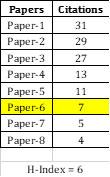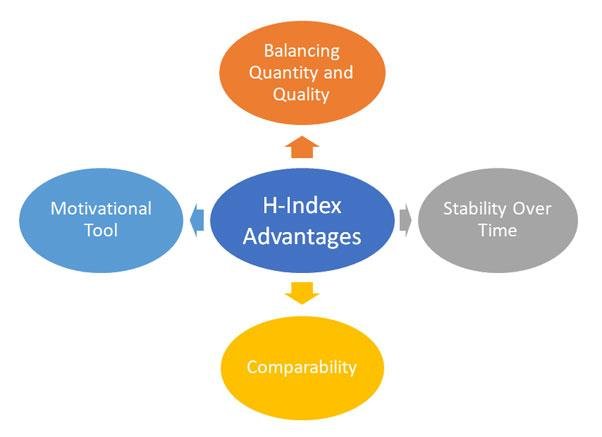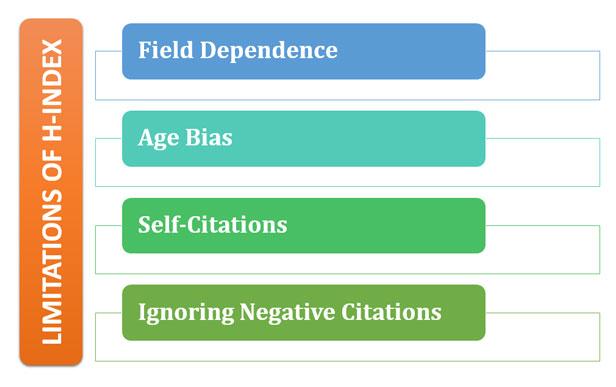The H-index, also known as the Hirsch index is a widely used bibliometric indicator used to measure the impact and productivity of a researchers in various academic and scientific disciplines. It is named after its creator Jorge E. Hirsch. H-index provides a quantitative measure of a researcher’s scholarly output and influence, capturing both the number of publications and the impact of those publications. This article summarizes concept and significance of the H-index, its calculation, its advantages, criticisms, and its applications in academic research
What is H-Index?
Ø The H-index is designed to overcome the limitations of other traditional measures of scholarly productivity, such as the total number of publications or the total number of citations.
Ø Metrices such as total number of publications of total citations provide some insight into a researcher’s work. However, they do not consider the distribution of citations across a researcher’s body of work.
Learn more: What is Journal Impact Factor
Ø The H-index aims to balance the quantity and quality of publications.
Ø H-index reflects a researcher’s impact by considering both their most cited papers and the overall body of work.
Ø The h-index can be calculated automatically in Web of Science and Scopus or manually in other databases that provide citation information (e.g. SciFinder, PsychINFO, Google Scholar).
How to Calculate H-Index?
Ø To calculate the H-index, one needs to compile a list of a researcher’s publications.
Ø Then, arrange them in descending order based on the number of citations each publication has received.
Ø The H-index is the highest number, h, for which there are at least h papers, each of which has been cited h times.
Ø The h-index is calculated based on two pieces of information:
- The total number of papers published (Np)
- The number of citations (Nc) for each paper
Ø For example, if a researcher has 15 papers that have each been cited at least 15 times, their H-index is 15.
Ø Another Example:
Ø This researcher has an h-index of 6, because six or more articles received six or more citations.
Advantages of the H-Index
The H-index offers several advantages as a bibliometric measure:
Balancing Quantity and Quality
Ø Unlike simple counts of citations or publications, the H-index considers both the number of papers and their impact.
Ø This provides a more balanced view of a researcher’s work.
Stability Over Time
Ø The H-index is less susceptible to sudden fluctuations, such as a single highly-cited paper or a sudden drop in citations.
Ø This stability makes it a reliable metric for assessing a researcher’s long-term impact.
Comparability
Ø The H-index is widely used across different fields and research areas, making it possible to compare researchers from diverse backgrounds.
Ø This comparability is valuable for grant agencies, academic institutions, and researchers themselves.
Motivational Tool
Ø The H-index can serve as a motivational tool, encouraging researchers to maintain a high level of productivity and the pursuit of influential research.
Applications of the H-Index
The H-index finds applications in various areas:
Academic Hiring and Promotion
Ø Academic institutions often use the H-index as a criterion for hiring and promoting faculty members.
Research Funding
Ø Grant agencies may consider the H-index when evaluating research proposals and distributing research funding.
Benchmarking and Collaboration
Ø Researchers use the H-index to identify potential collaborators and to compare their work with peers in their field.
Author Rankings
Ø Journals and academic databases use the H-index to rank authors and identify influential researchers in specific domains.
Criticisms and Limitations of H-Index
While the H-index has gained widespread acceptance, it has many criticisms and limitations. Some of them are summarized below.
Field Dependence
Ø The H-index is influenced by the citation practices of the specific research field.
Ø Some fields may have higher citation rates than others, making it difficult to compare researchers across different disciplines.
Age Bias
Ø Young researchers, even with high-quality work, may have lower H-indices due to the time it takes for their publications to accumulate citations.
Self-Citations
Ø Researchers can artificially inflate their H-indices by self-citing their own work, which raises questions about the fairness of the metric.
Ignoring Negative Citations
Ø The H-index does not account for negative citations or retractions, potentially skewing the assessment of a researcher’s impact.
Conclusion
The H-index, introduced by Jorge E. Hirsch, has become a valuable tool in the world of academia and scientific research. It provides a holistic view of a researcher’s impact by considering both the number and quality of their publications. While the H-index has its limitations and critics, it has proven to be a reliable and widely accepted metric for evaluating scholarly productivity and influence.
<<< Back to Research Methodology Notes
| You may also like NOTES in... | ||
|---|---|---|
| BOTANY | BIOCHEMISTRY | MOL. BIOLOGY |
| ZOOLOGY | MICROBIOLOGY | BIOSTATISTICS |
| ECOLOGY | IMMUNOLOGY | BIOTECHNOLOGY |
| GENETICS | EMBRYOLOGY | PHYSIOLOGY |
| EVOLUTION | BIOPHYSICS | BIOINFORMATICS |
| You may also like... | ||
|---|---|---|
| NOTES | QUESTION BANK | COMPETITIVE EXAMS. |
| PPTs | UNIVERSITY EXAMS | DIFFERENCE BETWEEN.. |
| MCQs | PLUS ONE BIOLOGY | NEWS & JOBS |
| MOCK TESTS | PLUS TWO BIOLOGY | PRACTICAL |



